 |
|
 |
|
Mosses in Your
Wildflower Garden
by Robert Muma from Wildflower magazine,
Summer 1986 issue (Vol. 2, No. 3)
|
|
|
|
In coastal areas where there is constant humidity from fog, mist or rain,
mosses can become pernicious weeds that must be kept under rigid
surveillance and controlled with commercial moss killers. But this garden
nightmare of the coast is the stuff of dreams for those of us who live in
drier climates and want to grow mosses. We see mosses thriving in their
woodland habitats and covet them for our own backyard enjoyment. We
carefully collect some, plant them and lavish them with tender loving care -
and then probably watch helplessly as they slowly die. Mosses are
extremely selective about their environment and are growing where you found
them because all the circumstances were exactly right for them in that time
and place. Moving them to another situation, no matter how seemingly
identical, may jeopardize their welfare by lack of some quite obscure
factor(s). |
|
|
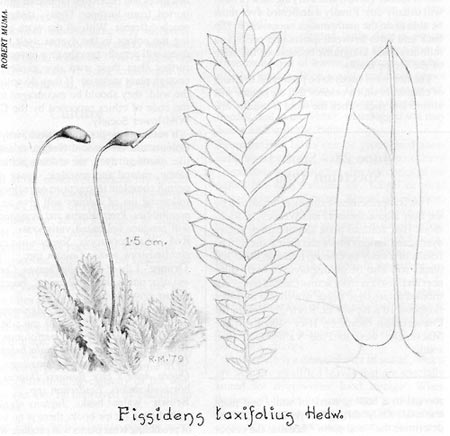 |
Fissidens taxifololius: A
common moss found on north facing slopes and along stream banks. It
has an extensive rhizoid system which makes it useful in preventing
erosion and forming clods of earth for easy transplanting. |
|
|
|
|
Next to lichens, mosses are probably the most environmentally sensitive group
of living things, and many species no longer grow within our urban or
industrial atmosphere. Thus it may be that it is not possible to
successfully transplant mosses which are not already native to that
locality. Some years ago I carefully planned and built a "natural" rock
garden with a pool and circulation pump and surrounding shrubbery as a
wildflower garden. Then about ten years ago when I became interested in
mosses, I thought I had what would be an ideal moss garden as well. So I
began planting samples of my collections as I brought them in. Throughout
the summer I maintained 35 species in healthy condition. Only a third of
these survived into the following spring however. And in 3 years scarcely
half a dozen of them were still living. These half dozen were species quite
common in the surrounding neighborhood anyway. Thus the cardinal rule for
growing mosses (as with all wild plants) is to duplicate as nearly as
possible, each species original habitat.
Transplanting mosses is quite a different matter from transplanting
fibro-vascular plants. For the latter, we simply dig a hole, insert the root
system and fill in firmly with earth. Mosses however have no root system to
plant in the soil. They only have short hairy fibres known as rhizoids which
serve as an anchoring system on whatever substratum is its natural habitat.
Thus when you collect moss for transplanting you have only a thin sod held
together by this network of filaments, and nothing to anchor it in place
until it becomes weathered and wedded to the soil in its new location. Every
gardener knows how notoriously curious squirrels are about anything newly
planted, and loose moss becomes a convenient toy for them. Skunks and
raccoons also, normally turn over every bit of moss they encounter for slugs
or other life that may be underneath. Even small birds will soon scratch a
loose patch of moss to bits. I found I had to make little cages of wire
netting to place over newly planted moss until it had become a firm part of
the new ecosystem. Another important precaution to this end is to pin the
moss down using pieces of wire hooked at one end to hold the moss in place.
In places where mosses may become a threat to a healthy lawn, owners
often resort to fertilizer to stimulate a more vigorous growth of grass,
believing this may then crowd out the moss. On the contrary , just the
opposite is apt to occur. Mosses need and thrive on phosphates, and soon
take over completely. The Japanese have long been famous for their moss
gardens covering large areas with a thick coat of moss of various species. I
have conflicting word-of-mouth reports only, of how it is possible to create
and maintain gardens like this, but anyone wishing to emulate their success
might consider a phosphates-rich environment as a necessary part of success. |
|
|
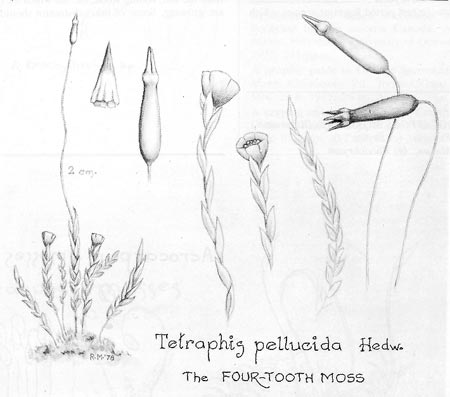 |
Tetraphis pellucida: A very
common cushion moss covering old rotten logs and stumps in deep,
shady, moist woods. |
|
|
|
|
Equally important for successful moss culture are almost constant shade and
plenty of moisture. Water them every day if possible. Mosses have no roots
to take nourishment from the soil directly. They get their total nutrient
requirements from the air and from minerals washed by rain from foliage
overhead. Tap water with its chlorine content may mean a slow death for
them. Tap water is also usually "hard" with a considerable calcium content.
Some mosses known as calciphiles, grow in fens or filter the calcium from
shallow mountain streams, building a cocoon of it from which they continue
to emerge endlessly. After centuries, rock formed in this way becomes many
meters deep. Non-calciphiles, on the other hand, after a summer of constant
sprinkling with tap water, may develop a whitish deposit of calcium and
gradually die. Rain water is best if it can be collected and saved for that
purpose. Or let tap water sit in a sprinkling can for a few hours to
dissipate the chlorine at least, before using. In any case, sprinkle through
overhead foliage for greater nutritional value. The growing season for
mosses begins with the melting snow in spring and continues as long as there
is adequate rain and the nights are cool. The heat and dryness of mid-summer
constitutes a hiatus or rest period for most species which may appear to be
dying. They revive quickly however with the return of rain and cool nights
of early fall and thrive hardily until covered by snow for the winter.
Spring and fall then, are the most appropriate times for collecting and
transplanting mosses. |
|
|
|
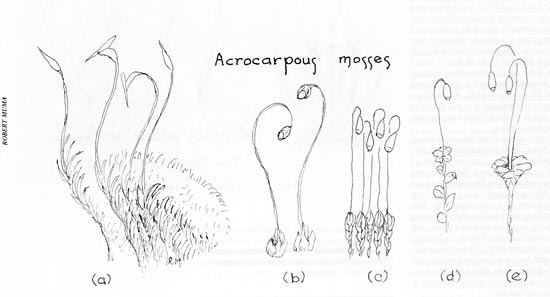
|
|
ACROCARPOUS MOSSES: (a) Dicranum
(b) Funaria (c) Bryum (d) Mnium (e)
Rhodobryum |
|
|
|
There are more than 450 different taxa of mosses found in Ontario representing
150 genera in 45 families. All of these can be sorted into just two easily
recognized growth forms. These are (I) Acrocarpous mosses which are
upright plants growing separately, or crowded together to form turfs or
cushions, and (2) Pleurocarpous mosses which are creeping plants,
lying flat on the substrata and forming mats. (See the author's
A GRAPHIC GUIDE TO ONTARIO MOSSES
on this website). |
|
|
|
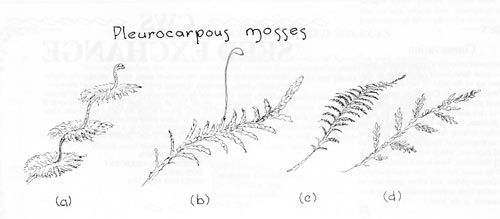
|
|
PLEUROCARPOUS MOSSES: (a) Hylocomium (b)
Pleurozium (c) Thuidium (d) Brachythecium |
|
|
|
All mosses are hygroscopic and able to store moisture in their stems and
leaves. Acrocarpous mosses, because of their gregarious nature, form
turfs or sponge-like cushions which increase their water storage capacity
and give them an advantage for survival in periods of drought. Thus the
species of this group should have a better chance of surviving transplant
than plants which have only their individual storage potential.
Pleurocarpous mosses absorb moisture from the soil, rotting wood, etc.
on which they are growing. Some of this substratum should be an essential
part of the transplant and the mosses should be covered loosely with leaves
afterward to help prevent drying. Following is a list of common genera for
each of these two groups which have representative species in almost all
parts of eastern North America: |
|
|
| ACROCARPOUS
Barbula
Bryum
Ceratodon
Dicranum
Fissidens
Mnium
Tetraphi |
PLEUROCARPOUS Amblystegium
Brachythecium
Campylium
Hypnum
Hylocomium
Thuidium
Pleurozium |
|
|
|
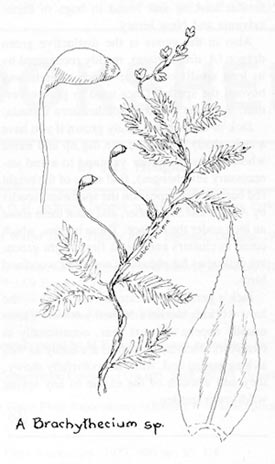 |
A Brachythecium species:
Brachythecium means "short capsule" which is characteristic
of the many species in this genus which is also pleurocarpous. |
|
|
|
FINAL GUIDELINES FOR MOSS CULTURE:
- Plenty of shade and moisture is the first essential.
- make your garden as natural as possible. Ideally, it should contain a
variety of soils as well as rotting wood, and a few rocks such as limestone
and granite in separate areas.
- Rocks, a board fence, or protective growth of some kind are necessary to
shield them from drying winds.
- Most important is the nature of the substratum from which the moss was
collected: the soil and its pH factor; living or rotting wood; rock, acid,
or alkaline. Transplant some of this substratum to blend into its new
habitat.
- Some mosses grow mainly in the shelter of one species of tree; others of
another species. Still others favour the proximity of certain metal-bearing
rocks. Putting your mosses in the wrong context may only provide them with a
hasty demise.
|
RECOMMENDED READING:
- Bryophytes, tiny treasures of the plant world. P.K. Armstrong.
The Morton Arboretum Quarterly 17(2):17-30. 1981
- Mastering the moss garden. J.L. Creech. The Mother Earth
News. Special series #9. Spring. 1984.
- Mosses of Eastern North America. H. Crum & L. Anderson. Columbia
University Press. New York. (2 vol.). 1981
- Mosses in landscape gardening. A.J. Grout. The Bryologist
34(5):64. 1931
- Gardens: cloaked in moss. T. Heineken. Architectural
Digest. Oct 1984. pp 162-166.
- Checklist of the mosses of Ontario. R.R. Ireland & R.F. Cain.
Pub. in Botany #5. National Museums of Canada. Ottawa. 1975. 67pp.
- Checklist of the mosses of Canada. R.R. Ireland et al.
National Museum of Natural Sciences, Ottawa. 1980. 75pp.
- Mosses in Japanese gardens. Z. Iwatsuki & T. Kodama.
Economic Botany 15:264-269. 1961
- Bryophyte and lichen succession on decaying logs in eastern Canada.
H. Muhle. PhD thesis. University of Ottawa. 1973. 241 pp.
- A graphic guide to Ontario mosses.
R. Muma. Toronto, Ontario. 1985. 28pp. (CLICK
HERE)
- A cryptogamic flora of Elgin County, Ontario. Part I. W.G.
Stewart. Ontario Field Biologist. 30(2):17-41.
|
|
|
|
Robert Muma is a biological
illustrator. bookbinder, leather craftsman, writer, gardener and
photographer. He lives in Toronto, Ontario where he has a personal herbarium
of over 2000 moss specimens from around the world. |
|

